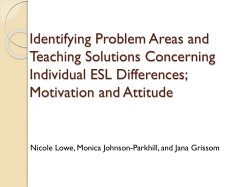
Vocabulary Instruction for EL*s
Vocabulary Instruction for EL’s By Carla Carrizosa M. Ed. National Board Certified Teacher Anita Archer Explicit Instruction Trainer Tier III Project G.L.A.D. Trainer Carla Carrizosa 2013 Purpose of Session Participants will be able to: • Understand how the brain learns -by Dr. David Sousa • Understand how the ELL brain learns specifically in regards to vocabulary- by Dr. David Sousa • Learn Margarita Calderon Strategies for Vocabulary Instruction • Learn Anita Archer Strategies for Vocabulary Instruction Carla Carrizosa 2013 Writing • Research by Jean-Luc Velay and Anne Mangen at the University of Stavanger’s Reading Centre in Norway – The act of handwriting activates the brain regions that help boost recall - Emanuel Medical CenterHealth Day, 2011 • http://www.uis.no/research-and-phd-studies/researchareas/school-and-learning/learningenvironment/better-learning-through-handwritingarticle29782-8869.html Jean-Luc Velay & Anne Mangen, Health Day How the Brain Learns by Dr. David A. Sousa • Learning is emotional = Long term memory (examples) • An individual will remember curriculum content in which they have made an emotional investment. David A. Sousa, How the Brain Learns, Chapter 3, 2006 Brain Research Emotions The Learning Environment (Classroom) Positive climate lends to endorphins in blood, which give a feeling of euphoria and stimulate frontal lobes (planning, high level thinking and focus occur) Negative climate leads to Cortisol in blood, which raises anxiety level and refocuses frontal lobe to flight or fight David A. Sousa, How the Brain Learns, Chapter 3, 2006 Learning Content Instructional activities which get students emotionally connected to the content of the learning Brain Research • Optimal Learning occurs between 7 a.m. to around 12 p.m. for pre/postadolescents and 8 a.m. to 1 p.m. for adolescents • Time when teaching and learning require more effort 12 p.m. to 2 p.m. for pre/postadolescents and 1 p.m. to 4 p.m. for adolescents David A. Sousa, How the Brain Learn, Chapter 3, 2006 Brain Research Teach New Material First Degree of Retention Prime Time 1 Prime Time 2 Practice Down time New Information 0 min 5 min 10 min 15 20 25 min min min Time in Minutes Closure 30 min David A. Sousa, How the Brain Learns, Chapter 3, 2006 35 min 40 min Lesson Length Brain Research 20 min Prime Time 40 min Rehearsal Prime Time 2 80 min. 0 20 40 60 David A. Sousa, How the Brain Learn, 2006 80 Brain Research Lesson Length 20 min. Divide into 20 minute segments Prime Time 1 40 min. Rehearsal Prime Time 2 Divide into 20 minute segments 80 min. 0 20 40 60 David A. Sousa, How the Brain Learn, 2006 80 Brain Research • Learning and retention are different we can learn something for just a few minutes and then lose it forever • Practice/Rehearsal is critical for long term storage David A. Sousa, How the Brain Learns, Chapter 3, 2006 Brain Research • Past Learning Helps in Present Learning – Link something from the learner’s past that helps add sense and meaning to the new learning – Select an experience which is clear, unambiguous, and closely relevant not just related to the learning (Romeo & Juliet/West Side Story-US Civil War/Vietnam War) – Sousa suggests journal writing as a closure strategy because this process helps Ss make connections to previous knowledge and organize concepts for long term storage David A. Sousa, How the Brain Learn, Chapter 4, 2006 Brain Research • Readers must possess a word in their mental dictionary to recognize the print • Children learn vocabulary words when they are explicitly taught individual words and word-learning strategies • Direct instruction is effective for teaching difficult words representing complex concepts which are not part of the child’s everyday experience David A. Sousa, How the Brain Learns, Chapter 5, 2006 Brain Research • Thinking Skills and Learning – Model Thinking Skills in the Classroom – Positive Learning Climate • • • • • Exhibit genuine interest Analyze own thinking process Change position if evidence warrants Admit mistakes Allow students to set rules, make decisions related to learning and assessment. • Encourage students to follow their own thinking not repeat teacher’s view • Prepare lessons that require higher order thinking to achieve learning objectives David A. Sousa, How the Brain Learn, Chapter 7, 2006 Brain Research • Putting it All Together – Learning engages the entire person (cognitive, affective, and psychological) – Human brains seek patterns – Emotions affect all learning, retention, and recall – Past experience affect new learning – Lecture = lowest degree of retention David A. Sousa, How the Brain Learn, Chapter 8, 2006 Brain Research • What did you learn about the brain? David A. Sousa, How the Brain Learn, 2006 ELL Brain Research • Left Hemisphere– Broca’s area reponsible for processing vocabulary, syntax, rules of grammar – Wernicke’s areas processes the sense and meaning of language • Right Hemisphere – Emotional meaning of language Cerebellum = control and movement, now known to be responsible for language David A. Sousa, How the Brain Learn, Chapter 1, 2006 How the ELL Brain Learns- by Dr. David A Sousa English Vocabulary Size at Three Years of Age in Various Economic Groups Social Economic Group Average Number of Words in Vocabulary Upper 1,116 Middle-Lower 749 Welfare 525 David A. Sousa, How the ELL Brain Learns, Chapter 1, 2011 The ELL Brain • Lexicon – The lexicon of a person is all the words they commonly use David A. Sousa, How the ELL Brain Learns, Chapter 1, 2011 The ELL Brain • Size of mental lexicon = the richness of the exposure to vocabulary word in their native language – Reliable predictor of how well student will learn to read • The ELL brain will attempt to match a new English word with its counterpart stored in the child’s native language lexicon. David A. Sousa, How the ELL Brain Learns, Chapter 1, 2011 ELL Brain Research • Acquiring vocabulary is not enough – EL’s must also know what the words means – English is a contextual language - a word can have a different meaning depending on context (Ex. run has a 120 definitions context is critical to the definition) – Knowing the word in context in which it is used is critical to full understanding David A. Sousa, How the Brain Learns, Chapter 3, 2006 The ELL Brain • Tool and Guidance- which vocabulary items to learn as well as help developing effective learning techniques • Lists-Use frequency lists David A. Sousa, How the ELL Brain Learns, Chapter 3, 2011 The ELL Brain • Cognates Using the L1 to facilitate the English form-to meaning linkage allows more of the brain’s cognitive resources to be focused on the English form itself freeup the brain to focus on learning the more contextualized types of word knowledge David A. Sousa, How the ELL Brain Learns, Chapter 3, 2011 The ELL Brain • Research done by Carlo et al. 2004 • Vocabulary Instruction – 10-12 vocabulary words a week – In the context of a thematic unit – Teachers used – Word association tasks – Analysis of word roots – Cloze David A. Sousa, How the ELL Brain Learns, Chapter 5, 2011 The ELL Brain • Research (Jimenez, 1997;Jimenez & Gamez, 1996) • Vocabulary Instruction – When students are taught how to deal with unknown vocabulary to recognize Spanish cognates in English and to use their background knowledge and to ask questions – Why? Students developed more awareness of their own cognitive behavior (metacognitive) as well as a positive attitude (emotional) towards reading both of which are characteristics of skilled readers David A. Sousa, How the ELL Brain Learns, Chapter 5, 2011 The ELL Brain • Himmele and Himmele (2009) • Vocabulary Instruction – Mind-Set. Make an intentional effort to speak using academic language – Synonymous Tags. Use academic language and make the meaning of words clear by using non-content-specific words – Meaningful Contexts. Obvious to the ELLs due to the context. – Visual Cues-select important words in the passage write them down on board or wall and rehearse them. Seeing the words repeatedly adds visual information in addition to saying them aloud. – Emotions. Create language rich lessons in which ELLs can hear the language in contexts that are comprehensible and engage their emotions through activities that are relevant and authentic. Ss can celebrate their emotional attachment to the learning. David A. Sousa, How the ELL Brain Learn, Chapter 5, Teaching Tip 5.2, 2011 The ELL Brain • Wang, Spencer, & Xing, 2009 • Metacognition – Critical for learning another language • Skill used by highly proficient readers of any language • Skills include – – – – Prereading Prewriting Word Analysis Methods for monitoring their reading comprehension David A. Sousa, How the Brain Learn, Chapter 5, 2006 ELL Brain Research • • • • • • • • Choral reading. In grades 1-6 Key words and pictures to help make connections Examples and non-examples. Enhances understanding Easily Pronounced Words. Initially select words which are easy for EL’s to pronounce correctly Cognates. Use cognates to help students see the connections between their language and English through the roots, prefixes, and suffixes Affective Filter -Safe environment to practice without criticism Tools. Teach comprehension monitoring so students can recognize when they do not understand and are able to ask for help Model – Think-out-Louds- Teacher or Student – Metacognition Strategies • Pair-share- Reciprocal peer teaching David A. Sousa, How the Brain Learns, 2006 The ELL Brain • Discuss 3 facts about how the ELL brain learns that are new to you? David A. Sousa, How the Brain Learn, 2006 Margarita Calderon • Student needs to understand 80-90 percent of the words in a sentence, paragraph, or test question in order to comprehend text • Levels of word knowledge 1. No knowledge 2. General sense of the word 3. Narrow, context-bound knowledge 4. Forgetting the word- knows the word but cannot recall, cannot apply in a meaningful way 5. Depth of word knowledge- knows it means two different things in other languages, use of idioms Margarita Calderon, Teaching Reading & Comprehension to English Learners, K-5, Chapter 6, 2011 Margarita Calderon • Preteaching Vocabulary through Explicit Instruction – Seven steps: 1. 2. 3. 4. 5. 6. 7. Teacher says, Ss repeat 3xs –Helps with pronunciation and introduces the print version Teacher reads and models word in a sentence (context) from text. Ss is able to remember the word in context Teacher gives dictionary/glossary meaning-SS is exposed to formal English Teacher explains meaning with student friendly definition gives examples that students can relate to. Teacher uses pictures, props, movement, or gestures to help students comprehend multiple meanings Teacher highlights aspect which may cause difficulty, spelling, polysemous, synonyms, antonyms, homophones, grammatical variations. Ss do more in depth word study Pair-share- all student involved orally- EL’s need to produce the word 10-12 times Teacher assigns peer reading with oral and written summarization using new vocabulary Margarita Calderon, Teaching Reading & Comprehension to English Learners, K-5, Chapter 6, 2011 Margarita Calderon • Teaching Tier I, II, and III words – Tier I • Basic words needed to communicate, read, and write – Tier II • • • • Information processing words Complex words Longer phrases Polysemous words –words with multiple meanings, use meaning in the text –(trunk) • Transition words • Connectors • Sophisticated words used for specificity in descriptions and rich discussions – Tier III • Subject specific, and content based Margarita Calderon, Teaching Reading & Comprehension to English Learners, K-5, Chapter 5 & 6, 2011 Margarita Calderon • Tier II Words –Teaching Long Phrases • Idioms – break a leg –get your head out of the clouds- he is in heaven- let’s get crack’n • (Noun) phrases – odd looking- act out • Prepositional phrases Margarita Calderon, Teaching Reading & Comprehension to English Learners, K-5, Chapter 6, 2011 Margarita Calderon Tier II Words Polysemous words (homonyms or homographs) across academic content areas • • • • • • Solution Table Round Divide Prime Round • • • • • • • Trunk State Power Cell Right Radical Leg Margarita Calderon, Teaching Reading & Comprehension to English Learners, K-5, Chapter 5 & 6, 2011 Margarita Calderon • Tier II Words – Sophisticated words and Specificity • Long term EL’s use the same simple words consistently • Providing them with increased vocabularies interventions will move EL’s from one level to another Margarita Calderon, Teaching Reading & Comprehension to English Learners, K-5, Chapter 6, 2011 Margarita Calderon • Tier II Words – Cognates • • • • Literature=literatura Context = contexto Irony = ironia Osmosis = osmosis – False Cognates • Library not Libreria/bookstore • Story not historia/history • Exit not exito/success Using Suffix patterns and Affixes (ex. alphabeto/ alfabetico alphabetizar/alphabet/alphabetic/alphabetize) Margarita Calderon, Teaching Reading & Comprehension to English Learners, K-5 2011 Margarita Calderon • Tier II Words – Homophones Sum Cell Weather Blew Whole Some Sell Whether Blue Hole (Imagine a whole cake) Margarita Calderon, Teaching Reading & Comprehension to English Learners, K-5 2011 Margarita Calderon • Which Margarita Calderon strategies will you use? Carla Carrizosa 2013 Anita Archer • Characteristics of Effective Vocabulary Instruction 1. Instruction is clear and unambiguous 2. Instruction involves presentation of word meaning and contextual examples 3. Multiple exposures to the word are provided 4. Sufficient instructional time is devoted to vocabulary instruction 5. Students are actively engaged in vocabulary instruction Anita L. Archer & Charles Hughes, Chapter 3, 2011 Anita Archer 1. Select words for explicit instruction 2. Develop or adopt student-friendly explanations 3. Develop examples and non-examples for introducing word or for checking understanding Anita L. Archer & Charles Hughes, Chapter 3, 2011 Anita Archer • Select a limited number of words for robust, explicit vocabulary instruction • Three to ten words per story, portion of story, or section of a chapter • Briefly tell students the meaning of other words needed for comprehension Anita L. Archer & Charles Hughes, Chapter 3, 2011 Anita Archer • Select words that are: – Unknown – Are critical to passage understanding – Students will encounter in future • Focus on Tier Two words • Academic Vocabulary • Select words that are more difficult to obtain, words with: – abstract versus concrete references – unknown concept – not adequately explained within the text Anita L. Archer & Charles Hughes, Chapter 3, 2011 Anita Archer • Tier I –Basic words • Tier II – Words in general use, but not common- General Academic Vocabulary • Tier III – Rare words limited to specific domain Background Vocabulary Anita L. Archer & Charles Hughes, Chapter 3, 2011 Anita Archer • Student Friendly Definition – Use known words – Easy to understand – Tell students the explanation or – Have them read the explanation with you – Don’t know the pronunciation go to www.howjsay.com – Dictionary for English Language Learner • (Collins COBUILD School Dictionary of American English) Anita L. Archer & Charles Hughes, Chapter 3, 2011 Anita Archer • Illustrate the word with examples – Visual Examples – Concrete examples • Object • Act out http://explicitinstruction.org/?page_id=96 • Examples and Non-Exampleshttp://explicitinstruction.org/?page_id=104 • Check student understand using examples Anita L. Archer & Charles Hughes 2011 Anita Archer 1. Introduce the part of speech 2. Introduce synonyms (same) antonyms (opposite). Homographs (same spellingdifferent meaning) 3. Tell students when and where the words is often used 4. Introduce the etymology (history and/or orgin) of the word Anita L. Archer & Charles Hughes 2011 Anita Archer • Archerism I do it 1. Introduce word 2. Present a student-friendly explanation 3. Illustrate the word with examples We do it (rehearsal) 4. Guide students in analyzing examples and nonexamples using critical attributes You do it 5. Check students’ understanding Anita L. Archer & Charles Hughes 2011 Review Participants you can: • Understand how the brain learns according to Dr. David Sousa – – – – Emotional Optimal Engagement Times Background Knowledge Direct and explicit instruction • • • • • Choral Reading Examples and Non-Examples Cognates Affective Filter Tools for Comprehending Text Carla Carrizosa 2013 Review • Understand how the ELL brain learns according to Dr. David Sousa – – – – – – – – – Lexicon dependent on Ss rich vocabulary in L1 Cognates Tool and Guidance Frequency Lists 10-12 Vocabulary List a Week Meaningful Contexts-Obvious Visual Cues Authentic and Relevant Activities –Emotional Cloze Carla Carrizosa 2013 Review • Understand Margarita Calderon’s strategies for Vocabulary Instruction – – – – – State the word in context from the text Say the word and asks students to repeat the word 3xs Provide student friendly definition Highlight grammar, spelling, polysemy Engage Ss in activities to develop word/concept knowledge – Remind students how/when to use the word Carla Carrizosa 2013 Review • Understand Anita Archer’s strategies for Vocabulary Instruction – Explicit instruction is critical for vocabulary instruction. – I do it, we do it, you do it. – Cognates – Tier I, II and III words Carla Carrizosa 2013 Quote “The limits of my language mean the limits of my world” Ludwig Wittgenstein Ludwig Wittgenstein Quote “Learning, as a language based activity, is fundamentally and profoundly dependent on vocabulary knowledge. Learners must have access to the meanings of words that teachers, or their surrogates use (to learn something new).” Baker, Simmons, & Kame’enui Baker, Simmons, & Kame’enui Quote • “Words are labels for our knowledge packets; the more words we have, the more packets of knowledge, the more background knowledge.” Marzano 2004 Marzano, 2004
© Copyright 2025










